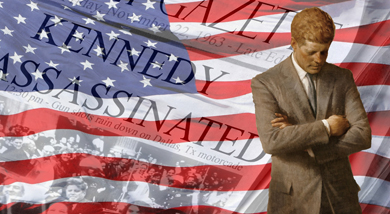A near full house turned up to enjoy Kennedy’s Children at the Down Arts Centre to mark the fiftieth anniversary of President Kennedy’s assassination. This was world-class theatre not in London’s West End, or New York’s Broadway, but in the provincial county town of Downpatrick on Northern Ireland.
The play written in the seventies by American playwright Robert Patrick has emerged as a lasting drama of the stage after a quiet beginning. Following its performances in London in the seventies, it literally took off and eventually made it to Broadway. The play is intense and certainly addresses adult themes.
[caption id="attachment_44820" align="alignleft" width="390"] Kennedy’s Children – a bar room scene in the 70’s in America as five people come to terms with the realities of their day.[/caption]
Kennedy’s Children – a bar room scene in the 70’s in America as five people come to terms with the realities of their day.[/caption]
The theme of Kennedy’s Children, performed by the Centre Stage Theatre Company, as Patrick indicates, is about loss… “the loss of heroes as guides for our lives. The form of the play is fragmentation, separation of people one from another.” It is this sense of alienation across American society in the 1960’s that Patrick’s play addresses. It pulls no punches.
Each of the characters speaking in monologue format pour out their deepest inner thoughts, their dreams, anxieties and fears, and reflect a generation dissilusioned to the core about where it has come from, where it is and where it is going.
Patrick’s method of having five widely ranging seventies characters create a montage of experiences reflecting the life of the 1960’s, is brilliant as much as breathtaking. The characters each hold your attention for long enough to get their message accoss then they seamlessly move to the next speaking in the scene in the New York bar.
This play emerged from a radical element in the US theatre scene in the seventies, at a time when gay plays began to appear, something which Patrick supported. And his character Sparger in Kennedy’s Children is understood to be based on his autobiographical background. Sparger’s description of life in the alternative off Broadway theatre he wanders into after being raped by three sailors in The Village is quite graphic and it appears almost as a circus for odd characters.
Patrick himself started work in an Off-Off Broadway theatre called Café Cino washing dishes and was smitten by the theatre bug and went on to write at a later date. He had been a poet and wrote The Haunted Host, an early play about the gay culture which was moderately successful. Patrick, originally from Texas, had grown up with parents who were intinerant workers and he never received a proper schooling but was fascinated by poetry and drama.
Patrick’s characters in Kennedy’s Children individually express their loss. For example, Rona, the hippie revolutionary in her idealism, misses the many heroes she met on her travels and pines for leadership. Mark, the former Vietnam vet, comes across as a broken, edgy character in a paranoid state having started on heroin and in his confusion sees both God and the Devil as his mentors. Very confusing for him ! Wanda’s world is shattered on the death of Kennedy there is complete dislocation about the news of his death and she still seems in a state about it. It is only after his death that she realises the importance of who he was as president.
And Carla, a young would-be actress sees her idols such as Marilyn Monroe die around her. She struggles to understand the exploitative culture of the theatre and film world that beckons her and strongly resists after having seen the dark side… but at a terrible price of an overdose. Even the butch Sparger loses his own personal hero when Buffo dies. They all commonly share loss through death.
The method of this play is brilliant. The characters do not react to each others monologues. They do not look at each other, and their body language ensures they are locked into their own-world experiences. The words the audience hear are inner thoughts, shared with the audience, in a bar of people all sitting quietly on their own. The characters do not engage with each other. It is the barman who moves around the bar creating a semblance of reality and real time that helps this play to work. It is quite experimental and is reminscent of the free association technigue used by contemporary authors of that period such as William Golding in “Freefall” who writes about a man falling from a plan to his death in a way that his thoughts are seamless emerging from his unconscious as he plunges to his death.
If you consider the dynamism of the sixties, the era of growing drugs use, sexual liberation, protests against Vietnam and for black and gay rights, and protests, and music such as Bob Dylan pressing the boundaries, with demands generally for a more open and liberal American society, then it was indeed a time to remember. A time when many young American people identified with great leaders such a JF Kennedy, public figures, and film and stage stars.
And so, ‘Kennedy’s Children’ in the play exhibit the traits of having suffered and experienced loss at a national level, centred around the theme of idols. It is an experience that traverses American society and brilliantly addressed by Richard Patrick and well performed by the Centre Stage Theatre Company.
Check out what’s on at: www.downartscentre.com phone – 028 44 610747 ]]>

























